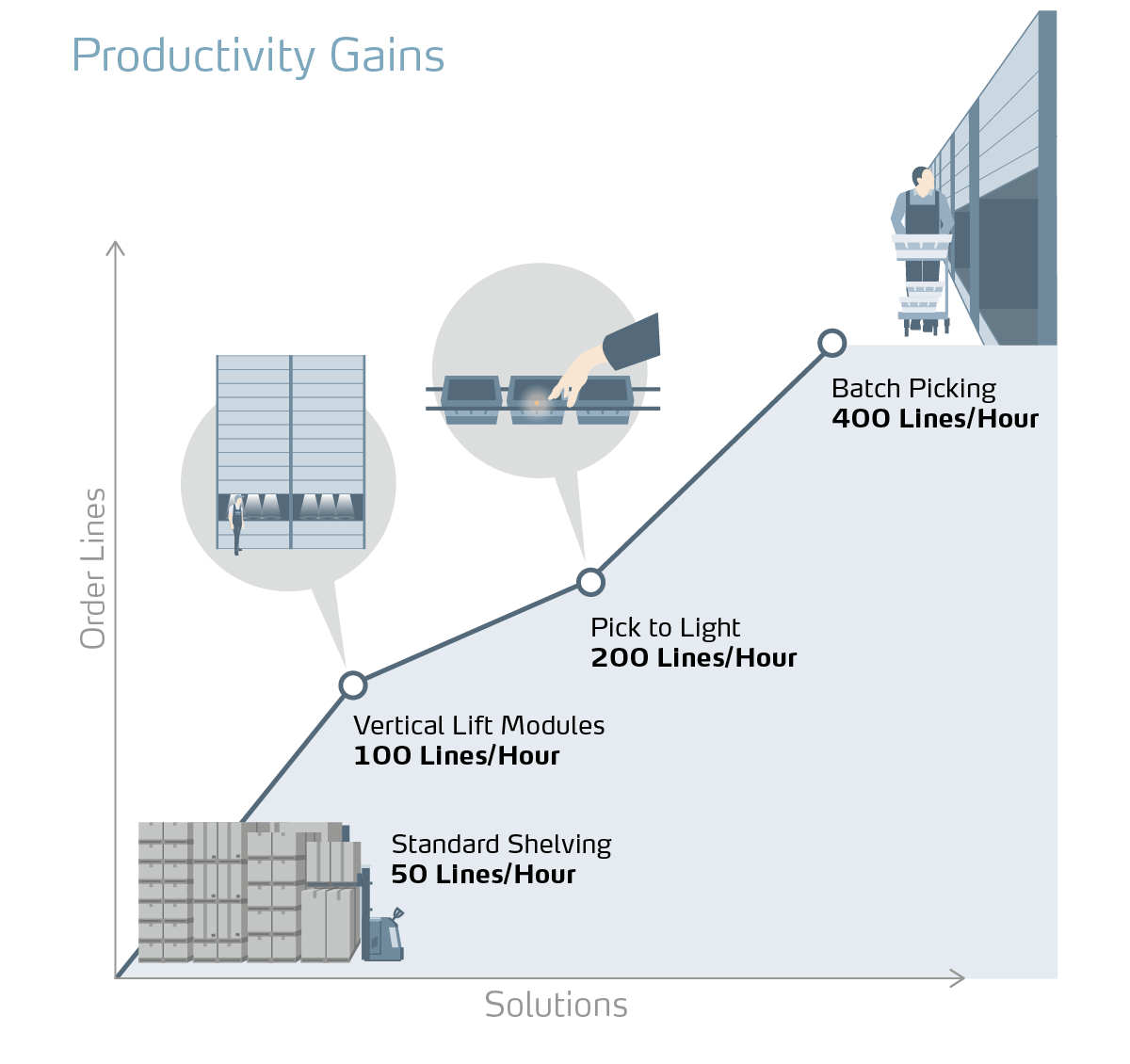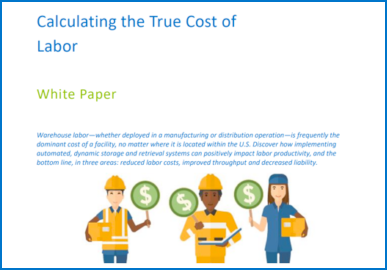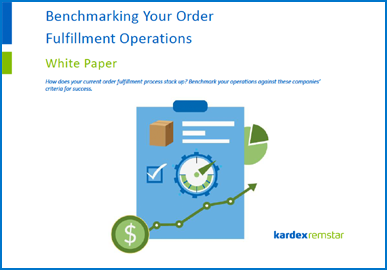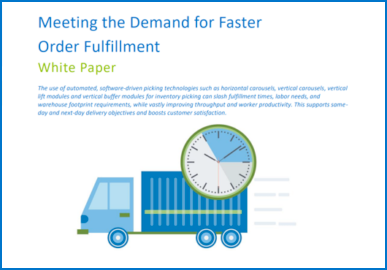Efficiency/Labor Costs – Increase order picking efficiency
while lowering your labor costs

Throughout the retail, distribution and manufacturing sectors, competitive pressures are driving the demand for faster, more-accurate order fulfillment. Consumers everywhere are demanding faster access to the retail goods they purchase — with next-day delivery having practically become the norm, and same-day delivery and in-store pickup on the rise. Similarly, for many manufacturers and operators of industrial processes, demand is growing for near-real time access to replacement inventory and spare parts to ensure uninterrupted operation.
To meet this customer demand, a growing number of distributors and centralized inventory-management warehouses are seeking improved warehouse-management. The goal is to use a combination of automation technologies and improved workflow processes to reduce the time required to pick, pack and ship items. Such an approach can help warehouses and distribution facilities to overcome the many shortcomings that are associated with the traditional storage and retrieval paradigm — an inherently slow and inefficient approach that typically stores inventory in or on static shelving, drawer systems, pallet racks that hold both palletized loads and single items, and cartons, and relies on a manual picking and order-fulfillment process time-consuming.

The process of manually retrieving and consolidating highly individualized orders within any warehouse or centralized distribution center is extremely labor- and time-intensive, typically involving a legion of workers walking multiple laps throughout the facility (sometimes on multiple floors), for hours at a time. Such plant workers handpick items according to their unique “stock keeping units” or SKUs and then transporting each order to the shipping zone. Adding more workers only compounds the problem, since it’s been shown time and time again that overcrowding causes picking rates to fall, as logjams force workers to wait, and the increased head count inevitably invites socializing, further hindering productivity.
A variety of automation technologies are available to improve both the speed and accuracy of the picking process. When such dynamic storage systems are coupled with improved workflow procedures related to order-fulfillment, picking and shipping, facilities are able to drastically improve picking times and accuracy — often enabling next-day delivery with later daily cutoff times. This improves overall inventory management within the facility and boosts customer satisfaction.
New Tools, New Strategies
Today, advances in warehouse-automation technologies and the increased use of optimized picking and fulfillment design strategies are helping forward-thinking warehouses and distribution centers to make the most of both their floor space and their labor pool, and to improve their own performance capabilities, in order to meet the demands of their customers. Specifically, the use of automation efforts related to parts picking and order fulfillment can yield the following improvements:
Improved Worker Productivity. By bringing products right to the picking personnel, automated picking systems reduce the time and effort required for manual search-and-retrieve efforts, and thus significantly boost picking efficiency, worker productivity and overall throughput rate and volume at the facility. Specifically, the use of automation can increase picking while reducing labor requirements.
Improved Picking Accuracy. In addition to improving turnaround time and enabling higher order-fulfillment volumes, today’s software-driven automated picking systems can also improve picking accuracy (to above 99%). This speeds order fulfillment and allows for later order-cut-off times without compromising same-day and next-day delivery guarantees. Such service capabilities give customers greater control over their inventory-replenishment needs and increases customer satisfaction.
Improved Space Utilization. By maximizing the use of underutilized overhead space from the floor to the ceiling, today’s dynamic storage and retrieval systems can reduce traditional floor space requirements by 65–85%. In many cases, this newfound floor space can be used to add inventory or bring existing inventory that is currently stored offsite back under the same roof. In other cases, this new facility space can also be used to carry out other revenue-generating activities at the facility.
Improved Working Conditions. As noted, today’s automated picking systems are designed with the worker in mind. Not only do they help to reduce arduous foot travel (and possible repetitive climbing of stairs) throughout the day, but the automated carousels that are at the heart of these improved systems feature an ergonomic design that presents the items to workers at waist height. This allows for easy picking and consolidation, while significantly reduces bending, reaching and carrying.
Automation Technology Options
Today, a variety of automation technologies and optimization strategies are available to help warehouse operators overcome the limitations and inefficiencies of the manual approach. And because these technology options are modular, today’s automated systems can be phased in over time. This gives warehouse managers great flexibility in terms of managing expenses and training issues and analyzing ongoing results to both fine-tune ongoing optimization efforts and analyze return on investment (ROI).
In all cases, the potential opportunities for improvement can be identified by an analysis of the inventory stored at the facility, in terms of picking size (for instance, can the inventory be characterized as picked by piece, by case or by pallet?), and by pick frequency, AKA pick velocity or SKU movement (for instance, can the inventory be characterized as fast-, medium-, slow- or very-slow-moving?).
Most companies tend to focus optimization efforts solely on the fastest-moving products in the facility. However, this approach is shortsighted, as this category of products typically comprises just a small fraction of the overall inventory. To fully exploit the benefits of automation, it is worth considering applying these improvement techniques to some or all of the slow- and medium-moving SKUs, as well.
Today, four main technology options are available to improve operational efficiency and increase fulfillment rates and throughput volume in warehouses and distribution centers: Horizontal carousels, vertical carousels, vertical lift modules (VLMs) and vertical buffer modules (VBMs). Each is discussed below.

- Vertical Buffer Module- In the middle of a multi-segment shelving system is an aisle, where a moveable mast with a telescopic gripper operates. The control unit sets the gripper in motion picking a bin and transporting it to a picking station.
- Vertical Lift Modules (VLMs) – An enclosed automated storage and retrieval system that consists of two columns of trays with an inserter/extractor in the center. The inserter/extractor automatically locates and retrieves stored trays from both columns and presents them to the operator at a waist-high pick window, eliminating travel and SKU search time.
- Vertical Carousel Modules (VCMs) – Comprised of a series of shelves that rotate around a track—similar to a Ferris wheel—these automated storage and retrieval systems deliver stored items safely and quickly to an ergonomically positioned work counter at the operator’s command, eliminating walk and item search time.
- Horizontal Carousel Modules (HCMs) – Consist of a fixed number of bins mechanically linked to an overhead or floor mounted drive track to form a complete loop. The oval track rotates horizontally to deliver storage locations to an operator at a picking location automatically. These automated storage and retrieval systems eliminate unproductive travel and search time by delivering the product to an operator.





